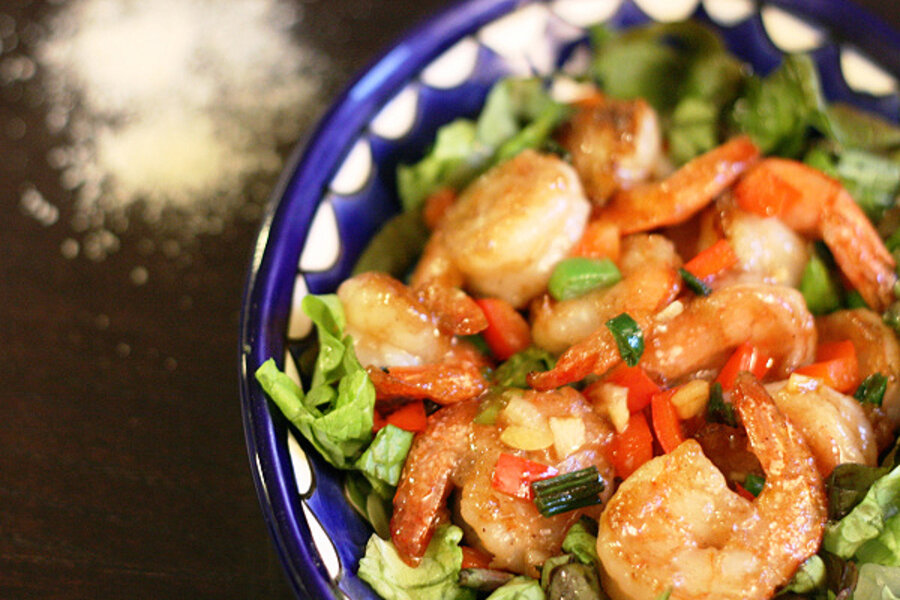Book review, author Q&A, and salt and pepper shrimp
Loading...
Ann Mah’s debut novel, "Kitchen Chinese: A Novel About Food, Family and Finding Yourself," has all the ingredients for a successful chick lit novel. It’s an easy, breezy read. It has a lovable heroine – Isabelle Lee – who has her flaws yet emerges victorious. And it offers so much more, especially for Asian Americans who hardly ever see themselves reflected in mainstream literature. Plus, the book is chock full of mouthwatering descriptions of the regional cuisines Isabelle samples in Beijing, Shanghai, and beyond.
Isabelle leaves behind debris of an ex-boyfriend and a dead-end editorial job in New York for the bright lights of big city Beijing. She moves in with her high-powered attorney sister, Claire, who helps her land a job as dining editor for an expat magazine. True to formula (and just the way I like it!), Isabelle bounces between two irresistible men, all the while struggling with her identity as American yet Chinese.
With her knowledge of the culture and language limited only to what Ann terms “kitchen Chinese” (hence the title of the book), Isabelle finds her way in Beijing’s fast-paced society and reconnects with her roots with a touch of self-deprecating humor, warmth, and somewhat wide-eyed innocence.
I couldn’t put the book down for many reasons. It was smart, funny and overall, a very engaging read. Three things really struck me:
1. Isabelle, with all her insecurities and self-doubts (about her identity, talents, allure, etc.) was very much like me. I could really identify with her character and I deemed her my soul sister!
2. The smattering of Mandarin words (written in Romanized hanyu pinyin) used throughout the book encouraged me to pick up Mandarin again.
3. All the luscious descriptions of regional specialties like jianbing, mabo tofu, and Peking duck made me so hungry I was enticed to either seek out recipes or call for takeout.
To give you a taste, I asked Ann to share a little bit about herself (do check out her blog) and her book and I hope you treat yourself or a friend to it.
Q+A with author Ann Mah
What inspired you to write this novel?
In 2003, my husband and I got married and a month later we moved from New York to Beijing. I gave up a job I loved in New York book publishing to become a diplomat’s wife. Initially, I was a little stunned – and I missed my job so much it felt like I’d amputated a limb – but slowly the local Chinese food ignited a spark to explore. This book grew out of those experiences.
You’ve admitted that Isabelle’s story is inspired by your own life. But how much is true to (your) life and how much is fiction? Did you embellish Isabelle’s character/life with elements you wish were present in your life?
Oh, of course! Isabelle is based loosely on my own experiences but ultimately I decided to write a novel because it allowed me to explore ideas of ethnicity and self-discovery more metaphorically. Isabelle is much braver than I am, especially when it comes to eating everything and traveling in the primitive Chinese countryside. And, unlike me, she’s lucky enough to have a sister.
You spent a year in Bologna, Italy, on a James Beard Foundation scholarship, and after living in Paris for several years you are now working on a book about regional French cuisine. But you are ethnically Chinese and grew up eating Chinese food. How important was it for you to write this book and to spotlight China and Chinese cuisine?
I love Chinese food but in my Chinese-American home, I grew up eating it every day so I thought I knew everything about it. But when I got to China, I was shocked to discover an enormous landscape of regional cuisines – everything from numbing peppercorns to Chinese cheese – stuff wildly different from the food in my parents’ house. Food became the bridge that drew me into China. But the tale that burned inside of me was of a young American woman – who happens to be Chinese – living in Beijing. Food is the metaphor that allows the main character to make peace with her circumstances.
Growing up in Southern California, were you raised with strict Chinese traditions? Did living in China and/or the process of writing this book connect you to your culture? What are your reflections on both?
My father is ethnically Chinese but he was born in the States and as a result I had a very American childhood and grew up with a very American perspective. Living in China actually made me feel more American than Chinese because I felt more accepted by my compatriots, who understood that the conflict of outer appearance and inner identity. It also made me appreciate the struggles faced by my grandparents, who must have experienced the same fish-out-of-water challenges in 1920s California that I faced in 21st century Beijing. And, after leaving China, I have to say I missed Chinese food for the first time in my entire life. I still do.
Unlike many households, your dad did most of the cooking. Did you find this odd? Can you share a favorite recipe your dad taught you?
My dad grew up in central California, the son of Chinese immigrants who owned a Chinese restaurant. When he moved to North Carolina for his first job, he missed his mom’s food so much he taught himself how to cook it. I love to imagine him growing bitter melons and gailan (Chinese broccoli) – he even made his own tofu (once). Some of my earliest memories are of sitting on the counter while he chopped garlic; he remains one of my favorite cooking partners. For his legendary dinner parties, he always makes a dish of salt and pepper shrimp – they’re so delicious, they can make even the most squeamish of eaters start to suck shrimp shells.
SPOILER ALERT– If you don’t want to know what happens in the end, stop reading now!
This question is to satisfy my personal curiosity. I like that you left Charlie and Isabelle’s relationship open-ended. I get annoyed when authors feel they have to give their characters a happy-ever-after ending. Was this intentional?
Ha ha – well, yes, I wanted Charlie and Isabelle to have a chance to be together, but who knows what happens to them in the end? I like to think Isabelle stays in China for a good long while, unlike me. Maybe she is my döppelganger in that sense.
Salt and Pepper Shrimp (Salad)
Ann learned to make this dish from her dad. She usually serves the shrimp as a salad with arugula or mixed greens tossed in balsamic vinegar, olive oil and sesame oil. I adapted the recipe a little, tweaking amounts as well substituting pine nuts for red bell pepper. I also chose to serve the shrimp as a main course on an undressed bed of shredded red lettuce.
Time: 30 minutes
Makes: 2 to 3 servings as part of a multicourse family meal
1/2 pound shrimp (about 20 31/40 shrimp), peeled, cleaned, and patted dry (*preferably fresh because frozen shrimp contains salt, and you may have to alter the amount of salt you use)
1-1/2 teaspoons salt-pepper-sugar mixture (recipe follows)
1 tablespoon cornstarch
2 tablespoons canola oil
1 plump garlic clove, minced
1 green onion, chopped
1/2 small red bell pepper, diced (about 1-1/2 tablespoons)
2 tablespoons dry sherry or white wine
Bed of shredded lettuce or mixed greens for serving
In a small bowl, toss the shrimp with the salt-pepper-sugar mixture and cornstarch until well coated.
Preheat a wok or large skillet. Swirl in the oil and heat over high heat until it starts to smoke. Add the shrimp and cook until they just turn pink (1 to 2 minutes on either side). Add the garlic, green onions, and red pepper and stir and cook until the garlic is fragrant, about 30 seconds.
Drizzle in just enough sherry to create a sauce that barely coats the prawns. Remove from the heat.
Place the shrimp on the bed of greens and serve with rice.
Salt-Pepper-Sugar Mixture
This is a master batch for your spice cabinet (about 6 batches). You can increase the quantities to make more and store it in a bottle. I used white pepper from the Asian store which in my opinion is spicier than black pepper. Feel free to adjust the ratio according to taste.
2 tablespoons ground black pepper or white pepper
1 tablespoon sea salt
1 tablespoon sugar
Combine all the seasonings in a small bottle or jar. Shake well and store for up to a month.








